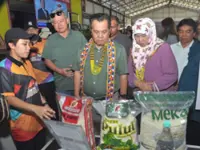KOTA KINABALU: Sabah’s vulnerability to landslides and earthquakes has prompted the Mineral and Geoscience Department to call on agencies to urgently adopt two newly developed geospatial systems to strengthen disaster preparedness and improve land-use planning.
The systems — the National Geospatial Terrain and Slope Information System (NaTSIS) and MyGEM — were presented during a four-day engagement programme in Sandakan that brought together 17 government agencies.





